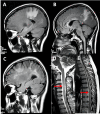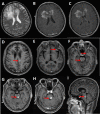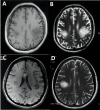Central nervous system tumefactive demyelinating lesions: Risk factors of relapse and follow-up observations
- PMID: 36532021
- PMCID: PMC9752826
- DOI: 10.3389/fimmu.2022.1052678
Central nervous system tumefactive demyelinating lesions: Risk factors of relapse and follow-up observations
Abstract
Objective: To track the clinical outcomes in patients who initially presented with tumefactive demyelinating lesions (TDLs), we summarized the clinical characteristics of various etiologies, and identified possible relapse risk factors for TDLs.
Methods: Between 2001 and 2021, 116 patients initially presented with TDLs in our hospital were retrospectively evaluated. Patients were followed for relapse and clinical outcomes, and grouped according to various etiologies. Demographic information, clinical data, imaging data, and laboratory results of patients were obtained and analyzed. The risk factors of relapse were analyzed by the Log-Rank test and the Cox proportional hazard model in multivariate analysis.
Result: During a median follow-up period of 72 months, 33 patients were diagnosed with multiple sclerosis (MS), 6 patients with Balo, 6 patients with neuromyelitis optica spectrum disorders (NMOSD), 10 patients with myelin oligodendrocyte glycoprotein antibody-associated demyelination (MOGAD), 1 patient with acute disseminated encephalomyelitis (ADEM), and the remaining 60 patients still have no clear etiology. These individuals with an unknown etiology were categorized independently and placed to the other etiology group. In the other etiology group, 13 patients had recurrent demyelinating phases, while 47 patients did not suffer any more clinical events. Approximately 46.6% of TDLs had relapses which were associated with multiple functional system involvement, first-phase Expanded Disability Status Scale score, lesions morphology, number of lesions, and lesions location (P<0.05). And diffuse infiltrative lesions (P=0.003, HR=6.045, 95%CI:1.860-19.652), multiple lesions (P=0.001, HR=3.262, 95%CI:1.654-6.435) and infratentorial involvement (P=0.006, HR=2.289, 95%CI:1.064-3.853) may be independent risk factors for recurrence. Relapse free survival was assessed to be 36 months.
Conclusions: In clinical practice, around 46.6% of TDLs relapsed, with the MS group showing the highest recurrence rate, and lesions location, diffuse infiltrative lesions, and multiple lesions might be independent risk factors for relapse. Nevertheless, despite extensive diagnostic work and long-term follow-up, the etiology of TDLs in some patients was still unclear. And these patients tend to have monophase course and a low rate of relapse.
Keywords: etiology; multiple sclerosis; prognostics; relapse; tumefactive demyelinating lesions.
Copyright © 2022 Li, Miao, Wang, Sun, Gao, Han, Li, Wang, Sun and Liu.
Conflict of interest statement
The authors declare that the research was conducted in the absence of any commercial or financial relationships that could be construed as a potential conflict of interest.
Figures




Similar articles
-
Tumefactive demyelinating lesions as a first clinical event: Clinical, imaging, and follow-up observations.J Neurol Sci. 2015 Nov 15;358(1-2):118-24. doi: 10.1016/j.jns.2015.08.034. Epub 2015 Aug 21. J Neurol Sci. 2015. PMID: 26333950
-
Frequency of New Silent MRI Lesions in Myelin Oligodendrocyte Glycoprotein Antibody Disease and Aquaporin-4 Antibody Neuromyelitis Optica Spectrum Disorder.JAMA Netw Open. 2021 Dec 1;4(12):e2137833. doi: 10.1001/jamanetworkopen.2021.37833. JAMA Netw Open. 2021. PMID: 34878547 Free PMC article.
-
Seropositive Neuromyelitis Optica in a Case of Undiagnosed Ankylosing Spondylitis: A Neuro-Rheumatological Conundrum.Qatar Med J. 2022 Jul 7;2022(3):29. doi: 10.5339/qmj.2022.29. eCollection 2022. Qatar Med J. 2022. PMID: 35864917 Free PMC article.
-
Seizures and epilepsy in multiple sclerosis, aquaporin 4 antibody-positive neuromyelitis optica spectrum disorder, and myelin oligodendrocyte glycoprotein antibody-associated disease.Epilepsia. 2022 Sep;63(9):2173-2191. doi: 10.1111/epi.17315. Epub 2022 Jul 10. Epilepsia. 2022. PMID: 35652436 Review.
-
Neuromyelitis optica spectrum disorders and myelin oligodendrocyte glycoprotein antibody-associated disease: current topics.Curr Opin Neurol. 2020 Jun;33(3):300-308. doi: 10.1097/WCO.0000000000000828. Curr Opin Neurol. 2020. PMID: 32374571 Review.
Cited by
-
Tumefactive Demyelinating Lesions: An Illustrative Pediatric Case With an Atypical Presentation and Literature Review.Cureus. 2024 May 28;16(5):e61207. doi: 10.7759/cureus.61207. eCollection 2024 May. Cureus. 2024. PMID: 38939300 Free PMC article.
-
Tumefactive demyelinating lesions: a retrospective cohort study in Thailand.Sci Rep. 2024 Jan 16;14(1):1426. doi: 10.1038/s41598-024-52048-w. Sci Rep. 2024. PMID: 38228919 Free PMC article.
References
Publication types
MeSH terms
LinkOut - more resources
Full Text Sources

